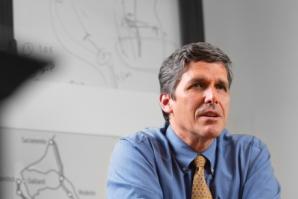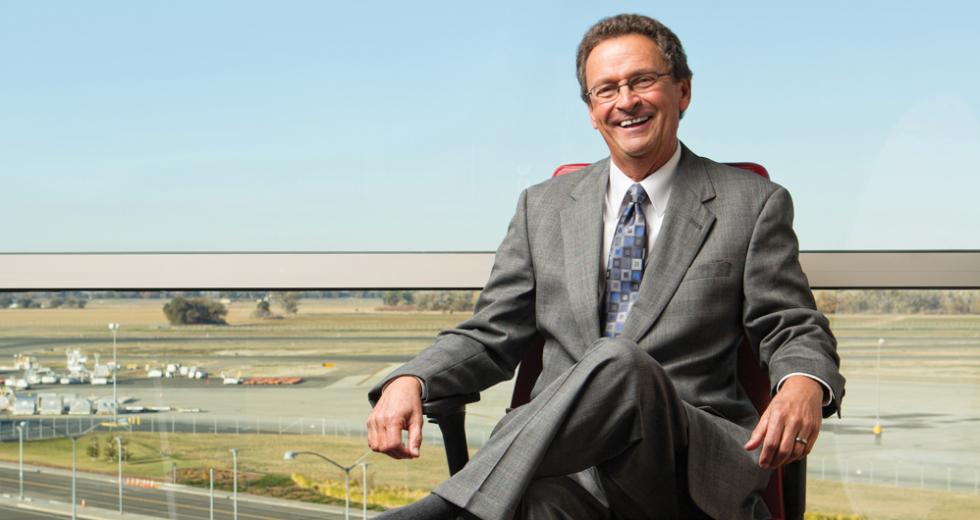He has been in the airport business for 30 years, including stints in Salt Lake City, Utah; and Tampa and Panama City, Fla. As system director, Wheat oversees the operation and maintenance of Sacramento International, Executive and Mather airports as well as Franklin Field.
John Wheat, 63, was named director of airports for the Sacramento County Airport System in April, 2013. He has been in the airport business for 30 years, including stints in Salt Lake City, Utah; and Tampa and Panama City, Fla. As system director, Wheat oversees the operation and maintenance of Sacramento International, Executive and Mather airports as well as Franklin Field.
“The challenge of making the Sacramento County Airport System fiscally viable is part of what attracted me to this job. We must reduce our costs by 10 to 15 percent within a year. Everything is on the table. Some very difficult decisions — including possible facility closures — must soon be made.”
“Sacramento International (Airport) absolutely has to carry the whole system. It generates a little over 96 percent of the revenues. International traffic is down 2.8 percent from last year. Overall, it’s down 28 percent from what was projected in 2008, which speaks to the expense issue. We really need to look at our expense side and figure out how we are going to lower that to ensure our financial success.”
“Great growth in the commercial aviation industry was projected throughout the country when the decision was made nearly 10 years ago to move forward on the new terminal facility at the international airport. Since that period, some major events have occurred to render that decision very economically challenging today.”
“The cost of fuel and salaries account for 88 percent of the cost of running an airline. At the same time, fuel prices were escalating, and the country went into a deep recession. This had a huge impact on people’s disposable income and the ability to spend money on travel. This reality caused the airline industry to drastically reduce seat capacity in the U.S. by as much as 15 percent. The former business model for operating an airline was put together when airline fuel was at $44 a gallon. Today, airline fuel is at $122. So you can see the challenge the airline industry has had making money over the past 15 years.”
“By reducing seating capacity, the airlines no longer have to offer cheap fares. They now only have to serve actual demand. There are no half-empty flights they have to worry about filling up. By being able to control their pricing, they are now beginning to show a profit for the first time in many years.”
“If you look back at history, all the airlines have gone into bankruptcy, with the exception of Southwest. It’s been a tough business. Now, with the ability to control capacity, the industry has changed dramatically. Mergers are taking place, and there has been an overall maturing of the industry. It is acting like all other U.S. industries, making business decisions based on profitability.”
“There is a demand out there today, but the demand is at a certain price level. The airlines have to make money flying the aircraft. So if that means the price per passenger for this flight needs to be $425, that’s the demand they are meeting. It doesn’t matter that there’s a pent-up demand across the U.S. for a $200 ticket. They have to be profitable. I don’t believe they’re going to let themselves get back to the point where they’re undercutting their ability to make a profit just to maintain market share.”
“Unfortunately for cities like Sacramento, that has meant a reduction in seats and a reduction in passengers. And for meeting operation costs at an airport facility, passenger count is key. The industry metric used for determining the per-passenger fee is the cost the airline pays to the airport divided by the number of passengers. Since 2006-2007, the peak period of the U.S. airline industry, we are down 20 percent in passengers. That’s a double whammy for us. Not only is our passenger count down, but we were already charging some of the highest fees due to the cost of building the new terminal. By having fewer passengers, that per-passenger fee to the airline just continues to increase.”
“We just charge the airlines the cost of operating our facility. Our goal is to get our airline fees down to a level where we are much more competitive with other California airports. To lower the cost of the passenger fee, we have to lower the expenses for our overall system.”
“The entire aviation industry has downsized. Due to the cost of fuel, there are a lot of competitive factors out there, especially with airfreight. It’s an expensive business. So we are looking at all of our assets (International, Executive, Franklin and Mather) [and their] 11 runways. That’s a lot of runways given the reality of today’s forecasted demand. We have to determine if we have more assets than demand. It certainly appears that we do.”
“If you have a lot of assets and demand is very low, one option is to look at the investment cost of closing one here versus one there. Is the investment you have to make in one going to produce a better financial picture than the other? Those are the questions we have to answer to map out the best future for the airport system.”
“We operate [Executive, Franklin and Mather] at a loss. When you factor in what it costs to operate an airport across the country, our situation is not necessarily unusual. You’re willing to do that because you’re pushing smaller aircraft out of International. You don’t want to mix the smaller aircraft with the larger commercial aircrafts. It’s part of the business plan. However, you’re always striving to get a facility to at least pay for itself.”
“Our analysis shows we will need to spend about $230 million in required capital improvement on those three facilities over the next 10 years. A good portion of that is on the basic maintenance, repair and reconstruction of those assets. It’s very expensive to replace a taxiway when it reaches the end of its useful life.
“About half of the 350 aircraft based at Executive go out on a monthly basis. Since the cost of fuel spiked to $100 a barrel in 2007, it has become prohibitively expensive for general aviation pilots to fly a lot. In general aviation, the purchase of onsite fuel is the biggest determining factor for whether a facility makes a profit or not. There’s no trend that shows the cost of fuel is going to come down anytime soon.”
“To stabilize our financial operation, we must make appropriate modifications on our expense side. We currently have the opportunity to look at everything we are doing in the region to ensure our financial future. It is very important to this region to have a facility like we have today at International. It goes hand-in-hand in growing the local economy. When business comes to Sacramento, they want to see a world-class airport. Continued success of the airport system is just going to add to the continued success of the region.”
“I’m always focused on the bottom line. We run a business. We’re always focused on how we can improve our level of service, generate the largest profit and be as efficient as possible.”
Recommended For You

The Conductor
The California High-Speed Rail Authority replaced an engineer with a political operative to lead the nation’s biggest public works project. Jeff Morales instantly charmed his opponents but made technical decisions that placed high-speed rail at the mercy of the courts. Can Morales save his runaway train?




